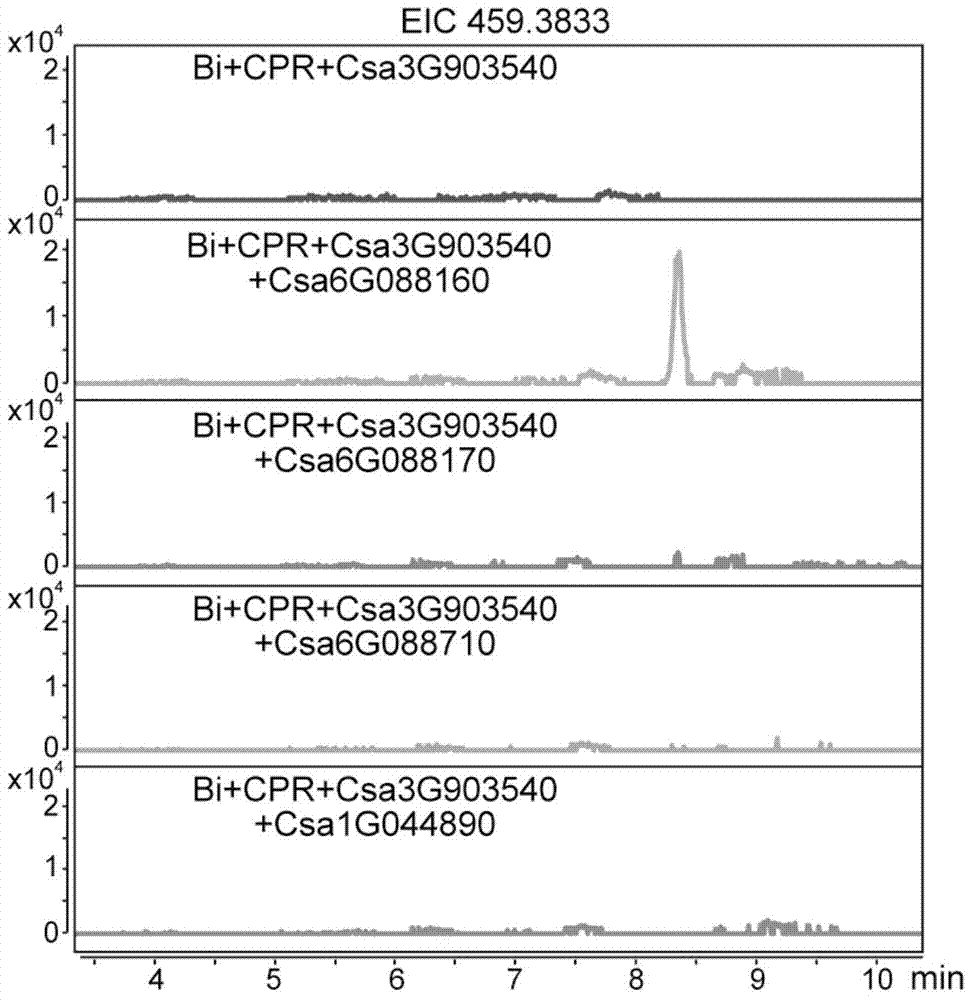Gene cluster participating in synthesis of cucumber cucurbitacine C and application thereof
A gene cluster and cucurbitacin technology, applied in the fields of genetic engineering and molecular biology, can solve the problems that the synthetic gene has not been cloned, the synthetic route is not clear, and cannot be directly synthesized in vitro, so as to speed up the breeding process
- Summary
- Abstract
- Description
- Claims
- Application Information
AI Technical Summary
Problems solved by technology
Method used
Image
Examples
Embodiment 1
[0022] Example 1 Mining and acquisition of gene clusters involved in the synthesis of cucumber cucurbitacin C
[0023] 1 Gene cluster mining
[0024] Bi genes are abundantly expressed in cucumber leaves. Taking this as a clue, the cucumber transcriptome data (RNA-Seq) was analyzed to find P450 genes and acetyltransferase genes co-expressed with Bi, and a total of 6 P450 genes were found in the cucumber genome ( Csa6G088160, Csa6G088170, Csa6G088710, Csa3G903540, Csa3G903550, and Csa1G044890) and one acetyltransferase gene (Csa6G088700). The expression status of these seven genes is very similar to that of Bi(Csa6G088690) in various tissues of cucumber, and they are only abundantly expressed in leaves ( figure 1 ). In addition, except for the three P450 genes (Csa3G903540, Csa3G903550, and Csa1G044890), other genes and Bi genes are located within 35kb of chromosome 6, forming a gene cluster-like structure ( figure 1 ). The distribution of cucurbitacin C in various tissues o...
Embodiment 2
[0033] Example 2 Using Yeast Expression System to Verify the Function of Candidate Genes for Bitterness Synthesis
[0034] Csa6G088160, Csa6G088170, Csa6G088710, Csa3G903540, Csa3G903550, Csa1G044890 genes and coenzyme CPR genes were respectively constructed on the expression vector pYES2 (Invitrogen), and transformed into yeast. Induce the yeast to express the protein and collect the yeast. After cracking, the compound was extracted with n-hexane. After the samples were prepared, they were detected by GC-MS (Agilent) or UPLC-Q-TOF. The results are as follows Figure 2-Figure 4 shown.
[0035] The CPR gene (SEQ ID No.20) is a coenzyme gene of the P450 gene in the oxidation substrate, adding CPR is beneficial to improve the oxidation reaction efficiency.
Embodiment 3
[0036] Example 3 Using Agrobacterium-mediated Tobacco Transient Expression Method to Verify the Function of Cucumber Bitter Gene Cluster
[0037] The Csa6G088160, Csa6G088170, Csa6G088710, Csa3G903540, Csa3G903550, Csa1G044890 and Csa6G088700 genes were constructed on the binary vector pBIN-Plus. They were respectively introduced into Agrobacterium EA105 by chemical transformation. Agrobacteria containing Bi(Csa6G088690), HMGR, FPS, Csa6G088160, Csa6G088170, Csa6G088710, Csa3G903540, Csa3G903550, Csa1G044890 and Csa6G088700 genes were cultured to OD 600 About 1.0, and then mix equal amounts into one piece, and inject Agrobacterium into tobacco about 6 weeks old with a syringe. Tobacco leaves were collected one week later, and the compounds in the leaves were extracted with methanol, followed by UPLC-Q-TOF (Agilent) detection. The result is as Figure 5 shown.
[0038] Since the HMGR gene (SEQ ID No.21) and the FPS gene (SEQ ID No.22) are involved in the synthesis of the su...
PUM
 Login to View More
Login to View More Abstract
Description
Claims
Application Information
 Login to View More
Login to View More - R&D
- Intellectual Property
- Life Sciences
- Materials
- Tech Scout
- Unparalleled Data Quality
- Higher Quality Content
- 60% Fewer Hallucinations
Browse by: Latest US Patents, China's latest patents, Technical Efficacy Thesaurus, Application Domain, Technology Topic, Popular Technical Reports.
© 2025 PatSnap. All rights reserved.Legal|Privacy policy|Modern Slavery Act Transparency Statement|Sitemap|About US| Contact US: help@patsnap.com



